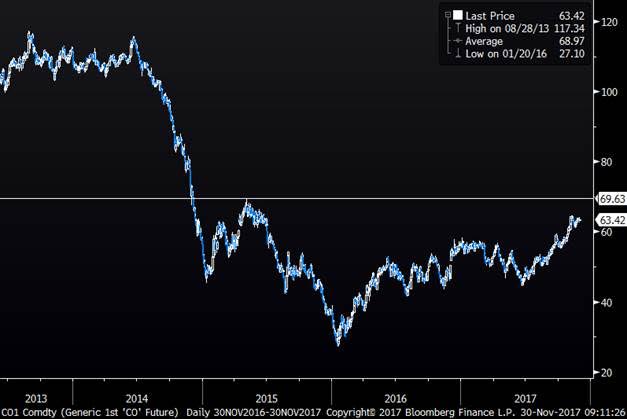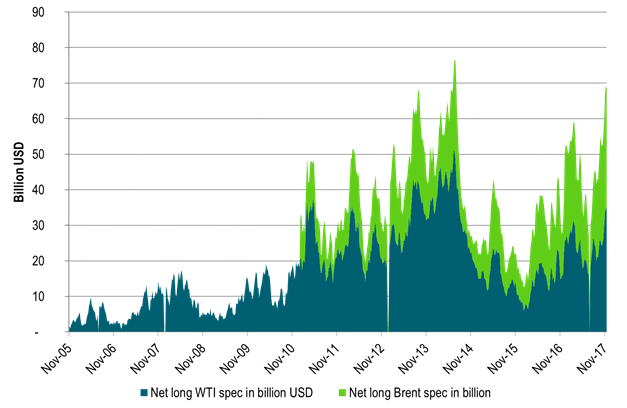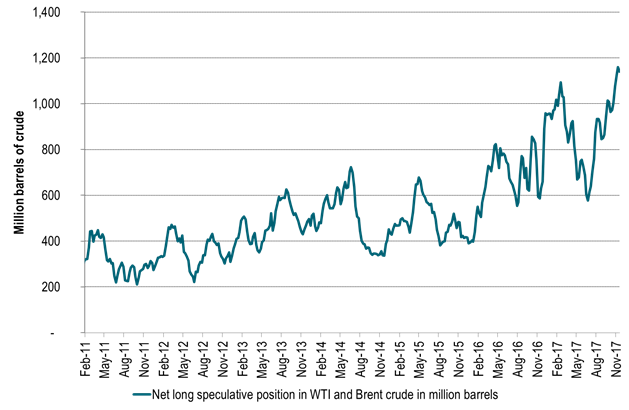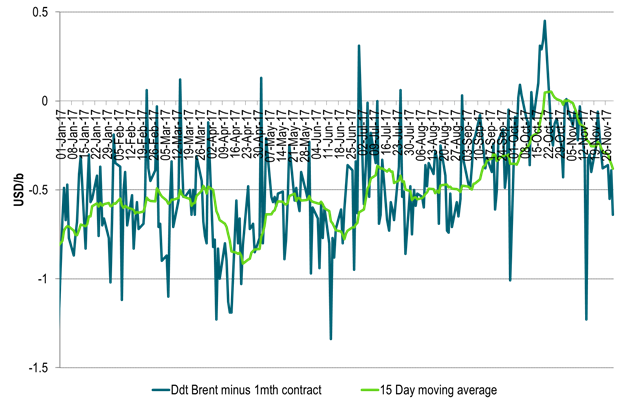Analys
The cutters should utilize seasonal strong demand in H2-18 to wind down cuts

 Headlines this morning gives the impression that all are now on-board for extending the cuts to the end of 2018. Reading in more detail however shows that it is not at all yet a done deal. And in addition it does not say whether the cuts will be maintained at current level all to the end of 2018. Specifically it seems like there is going to be an option to review and revise strategy at the next meeting in June. I.e. “maintain cuts if needed, but only if needed”. Russian producers are deeply concerned about the end-game. How to wind down the cuts without risking to crash the oil price. As such a sensible outcome in our eyes would be to wind down the cuts gradually through seasonal demand strength in H2-18. The cutters probably do not want to surprise the market positively risking firing up the oil price yet more at the same time as Rystad Energy is calling US crude oil production to hit 9.9 mb/d end of 2017 while also the US oil rig count has started to rise.
Headlines this morning gives the impression that all are now on-board for extending the cuts to the end of 2018. Reading in more detail however shows that it is not at all yet a done deal. And in addition it does not say whether the cuts will be maintained at current level all to the end of 2018. Specifically it seems like there is going to be an option to review and revise strategy at the next meeting in June. I.e. “maintain cuts if needed, but only if needed”. Russian producers are deeply concerned about the end-game. How to wind down the cuts without risking to crash the oil price. As such a sensible outcome in our eyes would be to wind down the cuts gradually through seasonal demand strength in H2-18. The cutters probably do not want to surprise the market positively risking firing up the oil price yet more at the same time as Rystad Energy is calling US crude oil production to hit 9.9 mb/d end of 2017 while also the US oil rig count has started to rise.
We have seen great reluctance from the Russian side in the run-up to this meeting and decision. Key has been the ”independent” oil companies in Russia who are getting ready dispatch new green field projects in 2018 in addition to what they have been holding back this year. These companies are getting very eager to get these new projects into production as well as the side lined once.
These companies fear that unconditional promises of cuts to the end of 2018 will fire up the oil market yet more with yet more stimulus of US shale oil production thus making it difficult for them to get back into the market at the start of 2019 without risking crashing the oil price then.
Thus exit of cuts has come into focus and has been a key point for Russian oil companies and thus the Russian delegation in Vienna.
I do not expect to see an unconditional extension of cuts to end of 2018 coming out of today’s meeting. A sensible outcome would be to keep current production cap through H1-18 and then ramp down the cuts through H2-18 during seasonally high demand in H2-18. And finally to have a touchdown in November 2018 assessing whether there is a need to trim production during seasonal weakness in H1-19.
This kind of outcome is probably less than what the market is hoping for and pricing in. Such an outcome would thus likely lead to some sell-off in the crude oil market.
Nonetheless in terms of appearance of price action ahead of the meeting the market seems extremely relaxed in terms of interpreting oil price action in the run-up to the meeting. I think the market is correctly assessing that OPEC/Non-OPEC is highly unlikely to throw away all what they have achieved over the past year (inventory draw down and a major shift from contango to backwardation, from spot price discount to spot price premium versus longer dated prices). However, it is probably wrong in assuming a full Christmas present with unconditional cuts to end of 2018.
Speculative net long crude oil positions in the market are currently at the second highest level in history. The fairly muted price action ahead of this meeting may thus be completely misguided in terms of possible price reaction to the outcome of this meeting in case the market is significantly disappointed by the outcome.
My expectation in terms of outcome of the meeting is thus that cuts are maintained during H1-18 and then gradually ramped down in H2-18 with a possible trimming during seasonal weakness in H1-19 if needed.
The message will be clear that they are NOT shifting from current strategy of “Price over volume” and back again to “Volume over price”. However, they are neither willing to drive the Brent crude oil price to the sky risking further strong acceleration of US shale oil production at the same time as OPEC/Non-OPEC cutters are holding back production. Yesterday’s news that US crude oil production is likely going to reach 9.9 mb/d by end of 2017 according to Rystad Energy’s estimates is a very clear message that OPEC/Non-OPEC cutters needs to tread carefully both when it comes to actual further cut extensions as well as how it communicates its plans and ambitions in terms of prices and goals.
As such the group should not really want to surprise the market positively today.
Rather it should want to give reassurance and confidence.
The perfect outcome for the group today would be if the oil price does not move at all.
Ch1: “I want $69.63/b!”
Brent crude oil 1mth contract in USD/bl
But the market has gone in a one way street upwards since June.
Will we get there this time around or will we need a round of speculative re-set before heading for the $69.63/bl at a later stage?
Ch3: And speculators have positioned themselves accordingly. A sell-off ahead in the making?
Riding the upwards trend since June has been a good thing adding more and more length on the way upwards
Ch4: Record high net long spec position (Brent + WTI) when counting contracts and barrels
Almost doubling since June!
There will be a reset at one point. Maybe today or maybe later
Ch5: Brent Dated crude oil price has started to weaken versus the Brent 1mth price signalling weakness in the physical Brent crude oil market
Should be trading on par if market is tight
Kind regards
Bjarne Schieldrop
Chief analyst, Commodities
SEB Markets
Merchant Banking
Analys
Brent crude set to dip its feet into the high $50ies/b this week

Parts of the Brent crude curve dipping into the high $50ies/b. Brent crude fell 2.3% over the week to Friday. It closed the week at $61.29/b, a slight gain on the day, but also traded to a low of $60.14/b that same day and just barely avoided trading into the $50ies/b. This morning it is risk-on in equities which seems to help industrial metals a little higher. But no such luck for oil. It is down 0.8% at $60.8/b. This week looks set for Brent crude to dip its feet in the $50ies/b. The Brent 3mth contract actually traded into the high $50ies/b on Friday.

The front-end backwardation has been on a weakening foot and is now about to fully disappear. The lowest point of the crude oil curve has also moved steadily lower and lower and its discount to the 5yr contract is now $6.8/b. A solid contango. The Brent 3mth contract did actually dip into the $50ies/b intraday on Friday when it traded to a low point of $59.93/b.
More weakness to come as lots of oil at sea comes to ports. Mid-East OPEC countries have boosted exports along with lower post summer consumption and higher production. The result is highly visibly in oil at sea which increased by 17 mb to 1,311 mb over the week to Sunday. Up 185 mb since mid-August. On its way to discharge at a port somewhere over the coming month or two.
Don’t forget that the oil market path ahead is all down to OPEC+. Remember that what is playing out in the oil market now is all by design by OPEC+. The group has decided that the unwind of the voluntary cuts is what it wants to do. In a combination of meeting demand from consumers as well as taking back market share. But we need to remember that how this plays out going forward is all at the mercy of what OPEC+ decides to do. It will halt the unwinding at some point. It will revert to cuts instead of unwind at some point.
A few months with Brent at $55/b and 40-50 US shale oil rigs kicked out may be what is needed. We think OPEC+ needs to see the exit of another 40-50 drilling rigs in the US shale oil patches to set US shale oil production on a path to of a 1 mb/d year on year decline Dec-25 to Dec-26. We are not there yet. But a 2-3 months period with Brent crude averaging $55/b would probably do it.
Oil on water increased 17 mb over the week to Sunday while oil in transit increased by 23 mb. So less oil was standing still. More was moving.
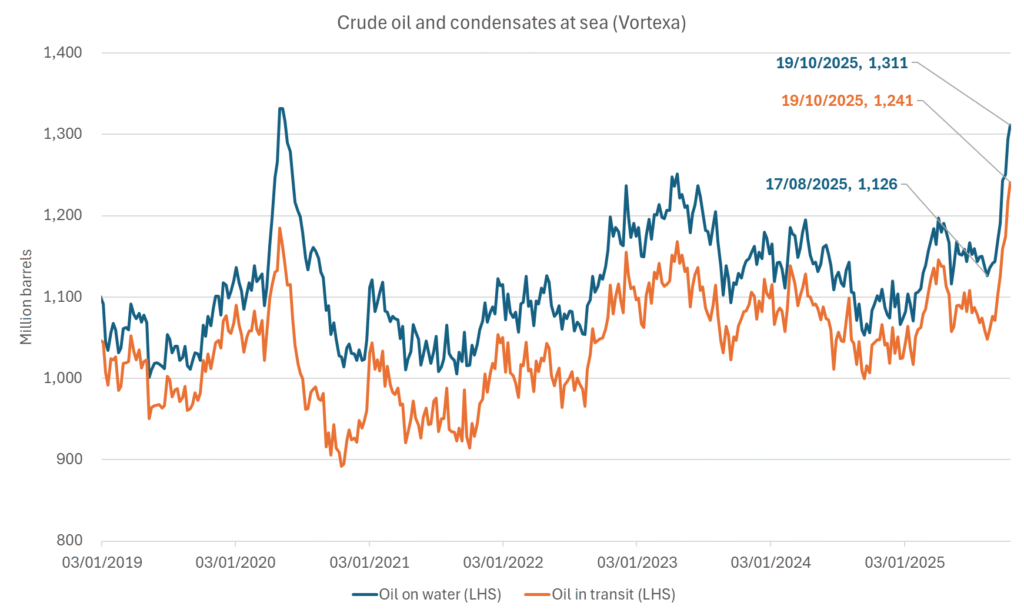
Crude oil floating storage (stationary more than 7 days). Down 11 mb over week to Sunday
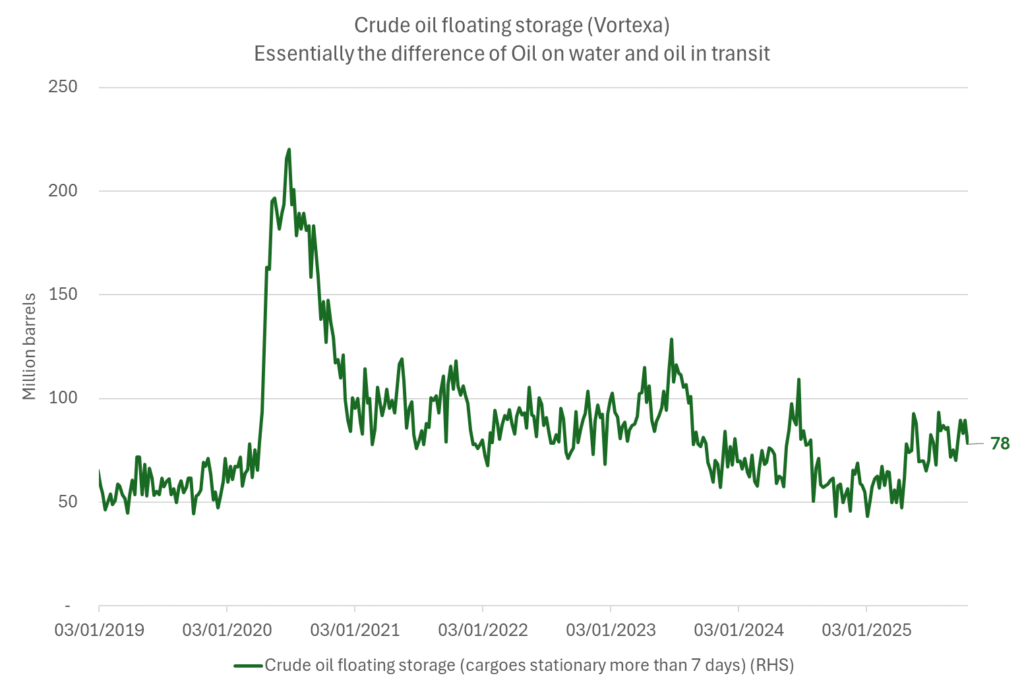
The lowest point of the Brent crude oil curve versus the 5yr contract. Weakest so far this year.
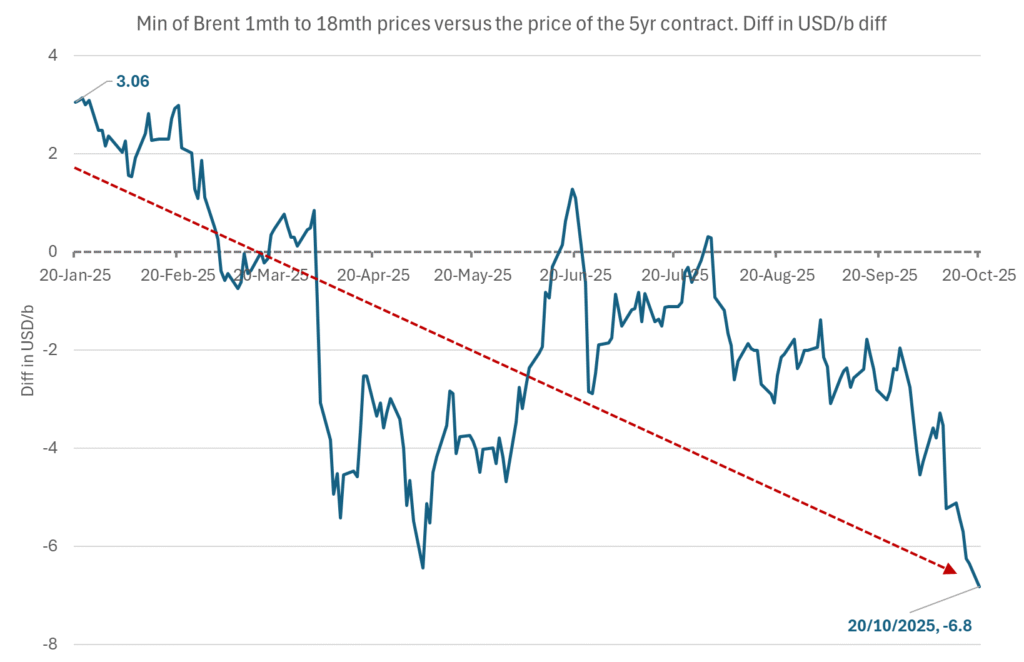
Crude oil 1mth to 3mth time-spreads. Dubai held out strongly through summer, but then that center of strength fell apart in late September and has been leading weakness in crude curves lower since then.
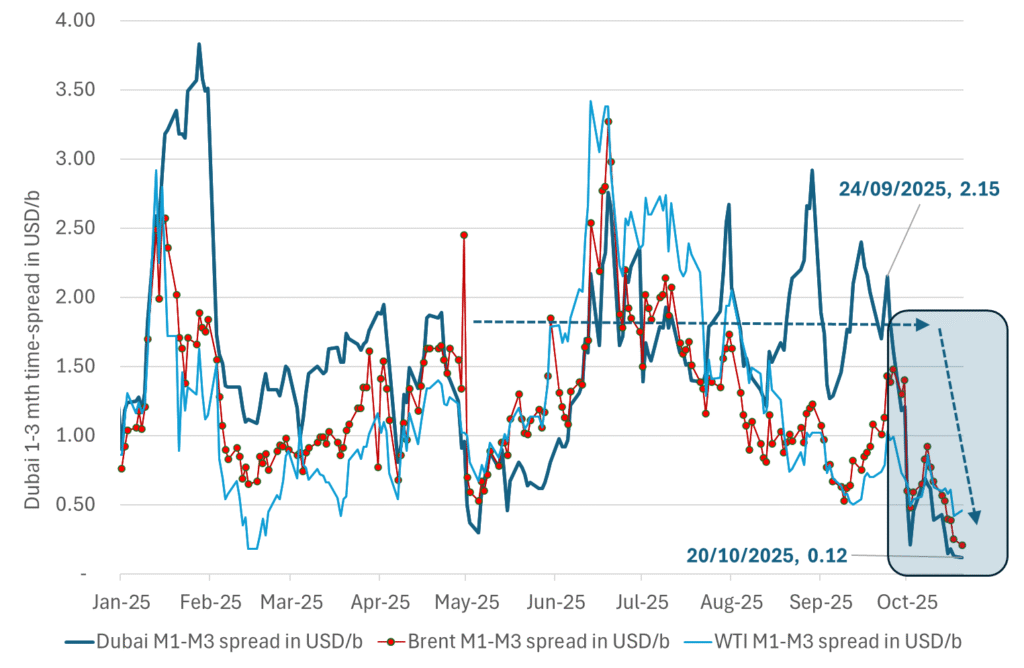
Analys
Crude oil soon coming to a port near you

Rebounding along with most markets. But concerns over solidity of Gaza peace may also contribute. Brent crude fell 0.8% yesterday to $61.91/b and its lowest close since May this year. This morning it is bouncing up 0.9% to $62.5/b along with a softer USD amid positive sentiment with both equities and industrial metals moving higher. Concerns that the peace in Gaza may be less solid than what one might hope for also yields some support to Brent. Bets on tech stocks are rebounding, defying fears of trade war. Money moving back into markets. Gold continues upwards its strong trend and a softer dollar helps it higher today as well.

US crude & products probably rose 5.6 mb last week (API) versus a normal seasonal decline of 2.4 mb. The US API last night partial and thus indicative data for US oil inventories. Their data indicates that US crude stocks rose 7.4 mb last week, gasoline stocks rose 3.0 mb while Distillate stocks fell 4.8 mb. Altogether an increase in commercial crude and product stocks of 5.6 mb. Commercial US crude and product stocks normally decline by 2.4 mb this time of year. So seasonally adjusted the US inventories rose 8 mb last week according to the indicative numbers by the API. That is a lot. Also, the counter seasonal trend of rising stocks versus normally declining stocks this time of year looks on a solid pace of continuation. If the API is correct then total US crude and product stocks would stand 41 mb higher than one year ago and 6 mb higher than the 2015-19 average. And if we combine this with our knowledge of a sharp increase in production and exports by OPEC(+) and a large increase in oil at sea, then the current trend in US oil inventories looks set to continue. So higher stocks and lower crude oil prices until OPEC(+) switch to cuts. Actual US oil inventory data today at 18:00 CET.
US commercial crude and product stocks rising to 1293 mb in week 41 if last nights indicative numbers from API are correct.

Crude oil soon coming to a port near you. OPEC has lifted production sharply higher this autumn. At the same time demand for oil in the Middle-East has fallen as we have moved out of summer heat and crude oil burn for power for air-conditioning. The Middle-East oil producers have thus been able to lift exports higher on both accounts. Crude oil and condensates on water has shot up by 177 mb since mid-August. This oil is now on its way to ports around the world. And when they arrive, it will likely help to lift stocks onshore higher. That is probably when we will lose the last bit of front-end backwardation the the crude oil curves. That will help to drive the front-month Brent crude oil price down to the $60/b line and revisit the high $50ies/b. Then the eyes will be all back on OPEC+ when they meet in early November and then again in early December.
Crude oil and condensates at sea have moved straight up by 177 mb since mid-August as OPEC(+) has produced more, consumed less and exported more.

Analys
The Mid-East anchor dragging crude oil lower

When it starts to move lower it moves rather quickly. Gaza, China, IEA. Brent crude is down 2.1% today to $62/b after having traded as high as $66.58/b last Thursday and above $70/b in late September. The sell-off follows the truce/peace in Gaze, a flareup in US-China trade and yet another bearish oil outlook from the IEA.

A lasting peace in Gaze could drive crude oil at sea to onshore stocks. A lasting peace in Gaza would probably calm down the Houthis and thus allow more normal shipments of crude oil to sail through the Suez Canal, the Red Sea and out through the Bab-el-Mandeb Strait. Crude oil at sea has risen from 48 mb in April to now 91 mb versus a pre-Covid normal of about 50-60 mb. The rise to 91 mb is probably the result of crude sailing around Africa to be shot to pieces by the Houthis. If sailings were to normalize through the Suez Canal, then it could free up some 40 mb in transit at sea moving onshore into stocks.
The US-China trade conflict is of course bearish for demand if it continues.
Bearish IEA yet again. Getting closer to 2026. Credibility rises. We expect OPEC to cut end of 2025. The bearish monthly report from the IEA is what it is, but the closer we get to 2026, the more likely the IEA is of being ball-park right in its outlook. In its monthly report today the IEA estimates that the need for crude oil from OPEC in 2026 will be 25.4 mb/d versus production by the group in September of 29.1 mb/d. The group thus needs to do some serious cutting at the end of 2025 if it wants to keep the market balanced and avoid inventories from skyrocketing. Given that IEA is correct that is. We do however expect OPEC to implement cuts to avoid a large increase in inventories in Q1-26. The group will probably revert to cuts either at its early December meeting when they discuss production for January or in early January when they discuss production for February. The oil price will likely head yet lower until the group reverts to cuts.
Dubai: The Mid-East anchor dragging crude oil lower. Surplus emerging in Mid-East pricing. Crude oil prices held surprisingly strong all through the summer. A sign and a key source of that strength came from the strength in the front-end backwardation of the Dubai crude oil curve. It held out strong from mid-June and all until late September with an average 1-3mth time-spread premium of $1.8/b from mid-June to end of September. The 1-3mth time-spreads for Brent and WTI however were in steady deterioration from late June while their flat prices probably were held up by the strength coming from the Persian Gulf. Then in late September the strength in the Dubai curve suddenly collapsed. Since the start of October it has been weaker than both the Brent and the WTI curves. The Dubai 1-3mth time-spread now only stands at $0.25/b. The Middle East is now exporting more as it is producing more and also consuming less following elevated summer crude burn for power (Aircon) etc.
The only bear-element missing is a sudden and solid rise in OECD stocks. The only thing that is missing for the bear-case everyone have been waiting for is a solid, visible rise in OECD stocks in general and US oil stocks specifically. So watch out for US API indications tomorrow and official US oil inventories on Thursday.
No sign of any kind of fire-sale of oil from Saudi Arabia yet. To what we can see, Saudi Arabia is not at all struggling to sell its oil. It only lowered its Official Selling Prices (OSPs) to Asia marginally for November. A surplus market + Saudi determination to sell its oil to the market would normally lead to a sharp lowering of Saudi OSPs to Asia. Not yet at least and not for November.
The 5yr contract close to fixed at $68/b. Of importance with respect to how far down oil can/will go. When the oil market moves into a surplus then the spot price starts to trade in a large discount to the 5yr contract. Typically $10-15/b below the 5yr contract on average in bear-years (2009, 2015, 2016, 2020). But the 5yr contract is usually pulled lower as well thus making this approach a moving target. But the 5yr contract price has now been rock solidly been pegged to $68/b since 2022. And in the 2022 bull-year (Brent spot average $99/b), the 5yr contract only went to $72/b on average. If we assume that the same goes for the downside and that 2026 is a bear-year then the 5yr goes to $64/b while the spot is trading at a $10-15/b discount to that. That would imply an average spot price next year of $49-54/b. But that is if OPEC doesn’t revert to cuts and instead keeps production flowing. We think OPEC(+) will trim/cut production as needed into 2026 to prevent a huge build-up in global oil stocks and a crash in prices. But for now we are still heading lower. Into the $50ies/b.
-

 Nyheter4 veckor sedan
Nyheter4 veckor sedanOPEC+ missar produktionsmål, stöder oljepriserna
-

 Nyheter4 veckor sedan
Nyheter4 veckor sedanEtt samtal om guld, olja, fjärrvärme och förnybar energi
-

 Nyheter2 veckor sedan
Nyheter2 veckor sedanGoldman Sachs höjer prognosen för guld, tror priset når 4900 USD
-

 Nyheter3 veckor sedan
Nyheter3 veckor sedanBlykalla och amerikanska Oklo inleder ett samarbete
-

 Nyheter3 veckor sedan
Nyheter3 veckor sedanGuld nära 4000 USD och silver 50 USD, därför kan de fortsätta stiga
-

 Analys4 veckor sedan
Analys4 veckor sedanAre Ukraine’s attacks on Russian energy infrastructure working?
-

 Nyheter4 veckor sedan
Nyheter4 veckor sedanGuldpriset uppe på nya höjder, nu 3750 USD
-

 Nyheter3 veckor sedan
Nyheter3 veckor sedanEtt samtal om guld, olja, koppar och stål


